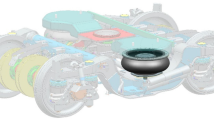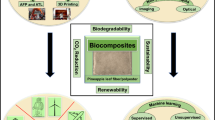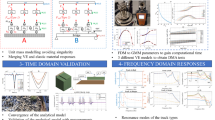Abstract
A considerable number of Post-Tensioned (PT) bridges have been constructed because PT systems enable them to carry significant traffic loads and have an aesthetical structure. However, strand corrosion has been a long-standing issue because it may lead to the failure of tendons and the deterioration of structural performance. The corrosion typically occurs in voided locations with exposed strands; thus, the inspection of voids in external PT tendons is important and necessary in order to protect strands before corrosion occurs. Based on literature review, several Non-Destructive Testing (NDT) methods are compared for effectiveness of identifying voids in external PT tendons, and the Impact Echo (IE), ultrasonic, and sounding inspection methods are then selected and assessed using small-scale and mock-up specimens. From the experimental results, the wave-based inspection methods, IE and ultrasonic methods, are difficult to apply in the field because the imperfect bonds between ducts and grouts obstruct the transmission of waves. However, the sounding inspection method is not affected by the discontinuities and successfully identifies voids in test specimens. Thus, the sounding inspection can be an effective tool for identifying voids because of its easy application in the field.
Similar content being viewed by others
References
ASBI (2000). American segmental bridge institute grouting committee: Interim statement on grouting practices, American Segmental Bridge Institute (ASBI), Phoenix, AZ, USA.
Biltz, J. and Simpson, G. (1996). Ultrasonic methods of non-destructive testing, Chapman and Hall, London.
Blum, F. (2003). A focused, two dimensional, air-coupled ultrasonic array for non-contact generation, MS Thesis, University of Stuttgart.
Carino, N. J. and Sansalone, M. (1990). “Impact-echo: A new method for inspecting construction materials.” NDT and NDE for Manufacturing and Construction, Hemisphere Publishing Corp., New York, pp. 209–223.
Carino, N. J. and Sansalone, M. (1992). “Detection of voids in grouted ducts using the impact-echo method.” ACI Materials Journal, Vol. 89, No. 3, pp. 296–303.
Corven, J. A. (2001). Mid-Bay bridge post-tensioning evaluation — Final report, Florida Department of Transportation (FDOT), Corven Engineering, Inc, Tallahassee, FL.
FDOT (1999). Corrosion evaluation of post-tensioned tendons on the Niles channel bridge, Florida Department of Transportation (FDOT), Tallahassee, FL, USA.
FDOT (2001). Sunshine skyway bridge post-tensioned tendons investigation, Florida Department of Transportation (FDOT), Parsons Brinckerhoff Quade and Douglas, Inc., Tallahassee, FL, USA.
Gamio, J. C., Ortiz-Alemán, C., and Martin, R. (2005). “Electrical capacitance tomography two-phase oil-gas pipe flow imaging by the linear back-projection algorithm.” Geofísica Internacional, Vol. 44, No. 3, pp. 265–273.
Hansen, B. (2007). “Tendon failure raises questions about grout in posttensioned bridges.” Forensic Engineering: Civil Engineering News, pp. 17–18.
Herman, G. T. (1980). Image reconstruction from projections: The fundamentals of computerized tomography, Academic Press, NY.
Hurlebaus, S., Jacobs, L. J., and Jarzynski, J. (1998). “Laser techniques to characterize the effect of geometry on acoustic emission signals.” Journal of Nondestructive Testing and Evaluation, Vol. 14, pp. 21–37.
Iaquinta, J. (2004). “Contribution of capacitance probes for nondestructive inspection of external post-tensioned ducts.” 16th World Conference on NDT, Session: Civil Structures.
Im, S. B., Hurlebaus, S., and Trejo, D. (2010a). “Effective repair grouting methods and materials for filling voids in external posttensioned tendons.” Transportation Research Record: Journal of the Transportation Research Board, accepted 2010.
Im, S. B., Hurlebaus, S., and Trejo, D. (2010b). “Inspection of voids in external tendons of post-tensioned bridges.” Transportation Research Record: Journal of the Transportation Research Board, accepted 2010.
Iyer, S. R., Schokker, A. J., and Sinha, S. K. (2003). “Ultrasonic C-scan imaging — Preliminary evaluation for corrosion and void detection in posttensioned tendons.” Transportation Research Record, No. 1827, pp. 44–52.
Iyer, S. R., Sinha, S. K., and Schokker, A. J. (2005). “Ultrasonic C-scan imaging of post-tensioned concrete bridge structures for detection of corrosion and voids.” Computer-Aided Civil and Infrastructure Engineering, Vol. 20, No. 2, pp. 79–94.
Karaoğuz, M., Bilgütay, N., Akgül, T., and Popovics, S. (1998). “Defect detection in concrete using split spectrum processing.” IEEE Ultrasonics Symposium, Vol. 1, pp. 843–846.
Kil, H.-G., Jarzynski, J., and Berthelot, Y. (1998). “Wave decomposition of the vibration of a cylindrical shell with an automated scanning laser vibrometer.” Journal of the Acoustic Society of America, Vol. 104, No. 6, pp. 3161–3168.
Kozlov, V. N., Samokrutov, A. A., and Shevaldykin, V. G. (2006). “Ultrasonic equipment for evaluation of concrete structures based on transducers with dry point contact.” NDE Conference on Civil Engineering, pp. 496–498.
Krause, M., Maierhofer, C., and Wiggenhauser, H. (1995). “Thickness measurement of concrete elements using radar and ultrasonic impulse echo techniques.” Proceeding International Conference on Structural Faults and Repair-95, London, UK, Vol. 2, pp. 17–24.
Krause, H. J., Wolf, W., Glaas, W., Zimmermann, E., Faley, M. I., Sawade, G., Neudert, G., Gampe, U., and Krieger, J. (2001). “SQUID system for magnetic inspection of prestressed tendons on concrete bridges.” Insight Nondestructive Testing and Condition Monitoring, Vol. 43, No. 7, pp. 458–461.
Li, J., Akl, L., Hunsperger, R., Liu, W., Chajes, M., and Kunz, E. (2005). “Time-domain reflectometry to detect voids in posttensioning ducts.” Journal of the Transportation Research Board, CD 11-S, pp. 243–252.
Martin, J., Broughton, K. J., Giannopolous, A., Hardy, M. S. A., and Forde, M. C. (2001). “Ultrasonic tomography of grouted duct posttensioned reinforced concrete bridge beams.” NDT&E International, Vol. 34, pp. 107–113.
Martínez, O., Akhnak, M., Ullate, L. G., and Espinosa, F. M. (2003). “A small 2D ultrasonic array for NDT application.” NDT&E International, Vol. 36, No. 1, pp. 57–63.
Martz, H. E., Roberson, G. P., Skeate, M. F., Schneberk, D. J., and Azevedo, S. G. (1991). “Computerized tomography studies of concrete samples.” Nuclear Instruments and Methods in Physics Research Section B, Vol. 58, No. 2, pp. 216–226.
Martz, H. E., Schneberk, D. J., Roberson, G. P., and Monteiro, P. J. M. (1993). “Computerized tomography analysis of reinforced concrete.” ACI Materials Journal, Vol. 90, No. 3, pp. 259–264.
Mendelsohn, Y. and Wiener-Avnear, E. (2002). “Simulations of circular 2D phase-array ultrasonic imaging transducers.” Ultrasonics, Vol. 39, No. 9, pp. 657–666.
Ortiz-Alemán, C. and Martin, R. (2005a). “Two-phase oil-gas pipe flow imaging by simulated annealing.” Journal of Geophysics and Engineering, Vol. 2, pp. 32–37.
Ortiz-Alemán, C. and Martin, R. (2005b). “Inversion of electrical capacitance tomography data by simulated annealing: Application to real two-phase gas-oil flow imaging.” Flow Measurement and Instrumentation, Vol. 16, pp. 157–162.
PCI (1997). Chapter 3: Fabrication and construction. PCI Bridge Design Manual, Prestressed Concrete Institute, Chicago, IL.
Pearson-Kirk, D. (2003). “The performance of post-tensioned bridge.” Role of Concrete Bridges in Sustainable Development — Proceedings of the International Symposium, pp. 129–140.
Pessiki, S. P. and Carino, N. J. (1988). “Setting time and strength of concrete using the impact-echo method.” ACI Materials Journal, Vol. 85, No. 5, pp. 389–399.
Pielstick, B. (2002). “Grouting of segmental posttensioned bridges in America.” Transportation Research Record, No. 1813, pp. 235–241.
Raiss, M. (1995). “Post-tensioned concrete bridges: The UK debate.” Concrete International, Vol. 29, No. 2, pp. 23–26.
Sansalone, M. and Carino, N. J. (1989). “Laboratory and field studies of the impact-echo method for flaw detection in concrete.” ACI Special Publication, Detroit, SP-112, pp. 1–20.
Schickert, M. (1995). “Towards SAFT-imaging in ultrasonic inspection of concrete.” Proceeding International Symposium of Non-Destructive Testing in Civil Engineering (NDT-CE), Vol. 1, pp. 411–418.
Schickert, M. (2005). “Progress in ultrasonic imaging of concrete.” Materials and Structures, Vol. 38, pp. 807–815.
Schickert, M., Krause, M., and Muller W. (2003). “Ultrasonic imaging of concrete elements using reconstruction by synthetic aperture focusing technique.” Journal of Materials in Civil Engineering, Vol. 15, pp. 235–246.
Schokker, A. J., Breen, J. E., and Kreger, M. E. (2001). “Grouts for bonded post-tensioning in corrosive environments.” ACI Materials Journal, Vol. 98, No. 4, pp. 296–305.
Scruby, C. B. and Drain, L. E. (1990). Laser ultrasonics: Techniques and applications, Adam Hilger.
Sprinkel, M. and Napier, C. S. (2008). “VDOT experience with grouted tendons in Varina-Enon precast segmental post-tensioned bridge.” Virginia Concrete Conference.
Tilly, G. P. (2002). “Performance and management of post-tensioned structures.” Proceedings of the Institution of Civil Engineers, Vol. 152, No. 1, pp. 3–16.
Tinkey, Y. and Olson, L. D. (2007). “Sensitivity studies of grout defects in posttensioned bridge ducts using impact echo scanning method.” Transportation Research Record: Journal of the Transportation Research Board, No. 2028, pp. 154–162
Tinkey, Y., Olson, L. D., and Wiggenhauser, H. (2005). “Impact echo scanning for discontinuity detection and imaging in posttensioned concrete bridges and other structures.” Materials Evaluation, Vol. 63, No. 1, pp. 64–69.
Trejo, D., Hueste, M. B., Gardoni, P., Pillai, R., Reinschmidt, K., Im, S. B., Kataria, S., Hurlebaus, S., Gamble, M., and Ngo, T. (2009). Effect of voids in grouted post-tensioned concrete bridge construction: Volume 2, Texas Department of Transportation (TxDOT), Austin, TX.
Woodward, R. J. and Miller, E. (1990). “Grouting post-tensioned concrete bridges: the prevention of voids.” Highways and Transportation, Vol. 37, No. 6, pp. 9–17.
Yang, W. Q. (1997). “Modelling of capacitance tomography sensors.” Science, Measurement, and Technology, IEE Proceedings, Vol. 144, No. 5, pp. 203–208.
Author information
Authors and Affiliations
Corresponding author
Rights and permissions
About this article
Cite this article
Im, S.B., Hurlebaus, S. Non-destructive testing methods to identify voids in external post-tensioned tendons. KSCE J Civ Eng 16, 388–397 (2012). https://doi.org/10.1007/s12205-012-1295-0
Received:
Revised:
Accepted:
Published:
Issue Date:
DOI: https://doi.org/10.1007/s12205-012-1295-0




